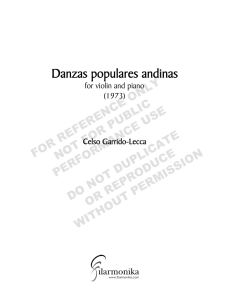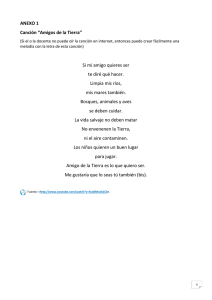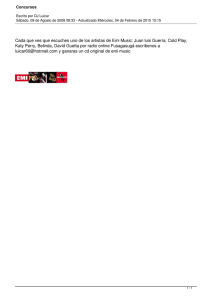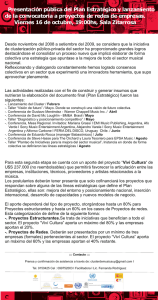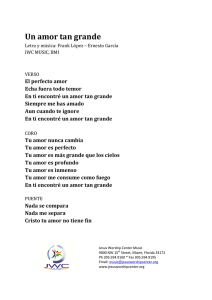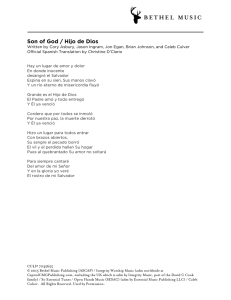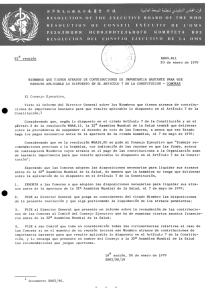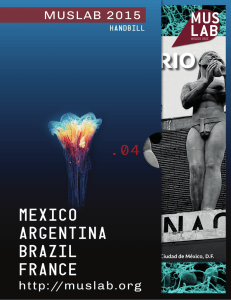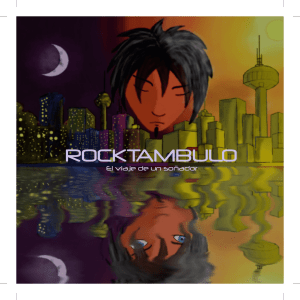Dúo concertante
Anuncio
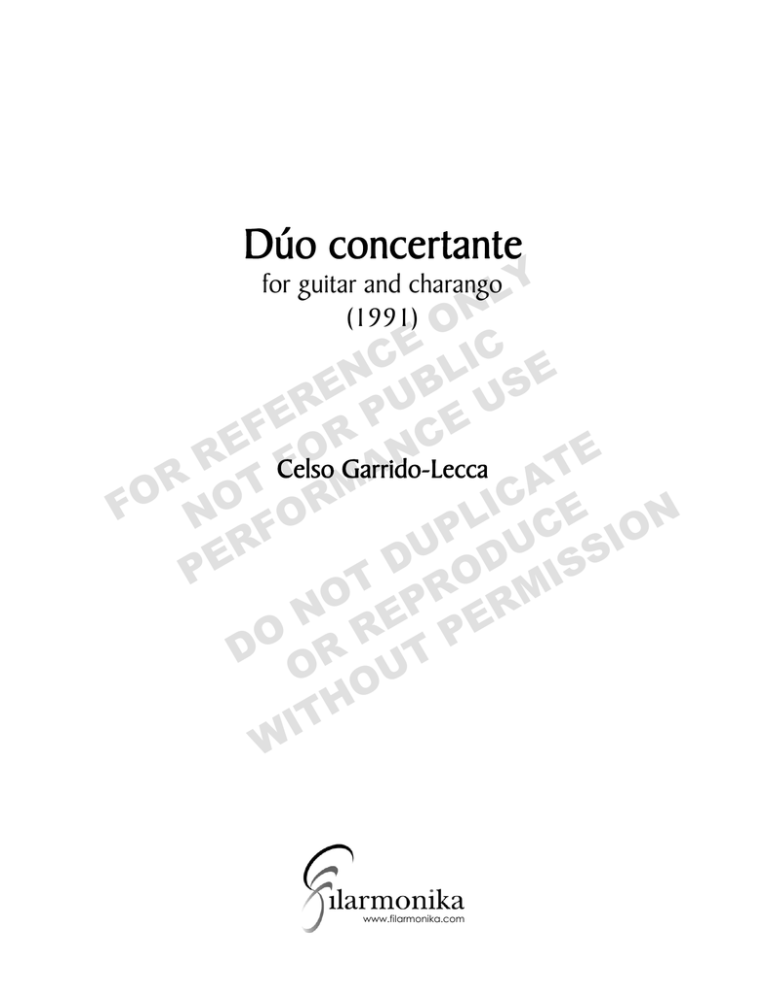
Dúo concertante for guitar and charangoLY (1991) ON E IC C L E N B S E U U R P E E F R C E O E N R Celso Garrido-Lecca F T A R T A M O C E I F NO OR N L C F P O I U R U D S E D S P I O T R RM O P N RE E P DO OR T U O H T I W www.filarmonika.com Celso Garrido-Lecca Biographical note Reseña biográfica Celso Garrido-Lecca was born in Piura, Peru on March 9, 1926. He studied music at the Sas-Rosay Academy, and later composition with Rodolfo Holzmann at the National Conservatory of Lima. In 1950, he traveled with a scholarship to Santiago, Chile to study with Domingo Santa Cruz and Free Focke at the National Conservatory. Focke introduced him to free twelve-tone techniques. He also got acquainted with the Second Viennese School and the work of contemporary Polish composers. Celso Garrido-Lecca nació en Piura, Perú, el 9 de marzo de 1926. Estudió música en la Academia Sas-Rosay, y composición desde 1947 con Rodolfo Holzmann en el Conservatorio Nacional de Música de Lima. En 1950 viajó becado a Santiago de Chile para estudiar con Domingo Santa Cruz en el Conservatorio Nacional, y luego con Free Focke, quien le inició en un dodecafonismo libre. Allí conoció la música de la Segunda Escuela Vienesa y de compositores polacos contemporáneos. In 1954 he was appointed sound engineer and later musical adviser and composer of the Theatre Institute at the University of Chile, where he wrote music for several plays in diverse styles. He wrote also music for films, and met Víctor Jara, central figure in the Chilean Nueva Canción movement, with whom he worked on various projects. En 1954 ingresó a trabajar como sonidista y luego como compositor y asesor musical al Instituto de Teatro de la Universidad de Chile, escribiendo música para obras en variados estilos. También realizó trabajos para cine. En esta época conoció al cantante Víctor Jara, principal figura del movimiento de la Nueva Canción Chilena, con quien colaboró en algunos proyectos. In 1961, Garrido-Lecca worked in New York with a scholarship from the International Education Institute, and received a Guggenheim scholarship to study orchestration with Aaron Copland in 1964. In 1965 he started teaching at the Department of Composition of the Faculty of Science and Musical Arts at the University of Chile, later becoming Chairman of the Department. In these years he participated in several international music festivals and Chilean Music Biennals. He was also appointed Chairman of the Association of Chilean Composers. En 1961 Garrido-Lecca residió en Nueva York gracias a una beca del Instituto Internacional de Educación, y en 1964 recibió una beca Guggenheim para perfeccionarse en orquestación con Aaron Copland. En estos años participó en varios festivales internacionales y Bienales de Música Chilena. Garrido-Lecca inició su labor pedagógica en 1965 en el Departamento de Composición de la Facultad de Ciencias y Artes Musicales de la Universidad de Chile, ocupando posteriormente el cargo de Jefe del Departamento hasta 1973. También fue Presidente de la Asociación de Compositores Chilenos. Y L N O E IC C L E N B S E U U R P E E F R C E O E N R F T A R T A M O C E I F NO OR N L C F P O I U R U D S E D S P I O T R RM O P N RE E P DO OR T U O H T I W In 1973, the military coup put him at risk because of his links to the Nueva Canción movement, and forced him to return to Peru. This Chilean period, when he became familiar with avant-garde styles, constitutes the his first creative phase, and includes his compositions Orden for piano (1953), the First Symphony (1960), Laudes I for orchestra (1963), Elegía a Machu Picchu (1965), and Antaras for two string quartets and double bass (1968). In Lima Garrido-Lecca became Professor of Composition at the National Conservatory, and soon after he was appointed its Director until 1979. He founded there an important Popular Music Workshop and also investigated popular instruments, genres and styles. This can be heard in his works of these years, which include the Popular Cantata Kuntur Wachana (1977), Danzas populares andinas (1979), Pequeña Suite Peruana (1979) and Retablos sinfónicos (1980). In the beginnings of the 1980s Garrido-Lecca coordinated important musicological projects, and since 1983 he is actively in contact with Chilean musical life. The stylistic period from those years forward is a synthesis between popular music, Nueva Canción and his own language, which includes a free serial technique, tonal elements, recurring chords and a search for instrumental color. Central works are Trío para un Nuevo Tiempo (1985), the Second string quartet (1987), the concerts for cello (1989) and guitar (1990), the Second symphony Introspecciones (2000), Secuencias for violin and orchestra (2002) and Canto vivo al atardecer for baritone voice and orchestra (2006). During his life as a composer he has been awarded many composition prizes both in Peru and in Chile. In 2000 he won the "Tomás Luis de Victoria" Prize of the Authors’ Foundation SGAE of Spain. He has been awarded Medals by the governments of Spain and Chile. El golpe militar de 1973 puso a Garrido-Lecca en peligro por su relación con el movimiento de la Nueva Canción, y tuvo que regresar al Perú. Su estancia en Chile conforma su primer período creativo, durante el cual se familiarizó con los estilos de vanguardia, y cuyas obras centrales son Orden para piano (1953), la Sinfonía no. 1 (1960), Laudes I para orquesta (1963), Elegía a Machu Picchu (1965) y Antaras para doble cuarteto de cuerdas y contrabajo (1968). En Lima, Garrido-Lecca enseñó Composición y Orquestación en el Conservatorio Nacional de Música, y luego fue nombrado Director hasta 1979, creando un importante Taller de Música Popular. Se familiarizó con instrumentos, estilos y géneros musicales populares, lo cual se refleja en su trabajo en obras como la Cantata popular Kuntur Wachana (1977), Danzas populares andinas (1979), Pequeña suite peruana (1979) y Retablos sinfónicos (1980). A inicios de los 80 Garrido-Lecca coordinó varias iniciativas musicológicas en el país, y desde 1983 retomó contacto con la vida musical de Chile. La etapa estilística posterior es una síntesis entre la música popular, la Nueva Canción y su propio lenguaje, que incluye una técnica serial libre, elementos tonales y ciertos acordes recurrentes, y una búsqueda del color instrumental. Obras representativas son el Trío para un Nuevo Tiempo (1985), el Cuarteto de cuerdas no. 2 (1987), los conciertos para violonchelo (1989) y guitarra (1990), la Sinfonía no. 2 Introspecciones (2000), Secuencias para violín y orquesta (2002) y Canto vivo al atardecer para barítono y orquesta (2006). Su obra ha ganado numerosos premios en Perú y en Chile. En el año 2000 obtuvo el premio “Tomás Luis de Victoria” otorgado por la Fundación Autor SGAE de España. Además ha sido condecorado por los gobiernos de España y Chile. 1 Y L N O E IC C L E N B S E U U R P E E F R C E O E N R F T A R T A M O C E I F NO OR N L C F P O I U R U D S E D S P I O T R RM O P N RE E P DO OR T U O H T I W 2 Y L N O E IC C L E N B S E U U R P E E F R C E O E N R F T A R T A M O C E I F NO OR N L C F P O I U R U D S E D S P I O T R RM O P N RE E P DO OR T U O H T I W © 2011 FILARMONIKA LLC (ASCAP) FILA 1108-150510 3 Y L N O E IC C L E N B S E U U R P E E F R C E O E N R F T A R T A M O C E I F NO OR N L C F P O I U R U D S E D S P I O T R RM O P N RE E P DO OR T U O H T I W
